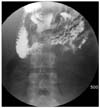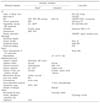Abstract
There are many causes of chronic and/or recurrent vomiting. The differential diagnosis is sometimes difficult because the clinical manifestations are often similar with each other. In this review, common causes of chronic and/or recurrent vomiting, and a general approach to children with vomiting are described. The involuntary passage of ingested material from the stomach into the esophagus, gastroesophageal reflux (GER), is a common event in infants. GER-disease can arise when the refluxed material causes esophagitis, resulting in pain, impaired esophageal function, poor growth or some respiratory symptoms. Esophageal impedance-pH meter will be the golden standard test in these cases. Parental reassurance and dietary management are expected to be the important components of managing mild GER-disease. Eosinophilic esophagitis is a clinicopathological disease characterized by (1) Feeding intolerance and GER-disease symptoms in children; (2) >15 eosinophils/HPF; (3) Exclusion of other disorders associated with similar clinical, histological, or endoscopic features, especially GERD. Appropriate treatments include dietary approaches based upon eliminating exposure to food allergens, or topical corticosteroids. Cyclic vomiting syndrome (CVS), a paroxysmal, especially severe, recurrent vomiting disorder, may be second to GER-disease as a cause of recurrent vomiting in children. It is highly incapacitating brain-gut disorder. The different diagnosis of CVS cuts a broad swath across neurologic, gastrointestinal, renal, metabolic, and endocrinologic disorders. Treatment is divided between acute intervention, when a patient is actively and severe vomiting, and prophylactic treatment in their interictal phase, the goal of which is reducing frequency and intensity of subsequent episodes.
Figures and Tables
 | Fig. 1Superior mesenteric artery syndrome. Contrast study showing partial obstruction in the third portion of the duodenum by the superior mesenteric artery. |
Table 1
Evaluation of Cyclic Vomiting Pattern

*All testing below obtained during the episode, except, †In non-fasted state, ADH: anti-diuretic hormone, δ-ALA: delta aminolevulinic acid, CCK: cholecystokinin, HIDA: 99mTC-HIDA scintigraphy, HVA: homovanilic acid, VMA: vanillylmandelic acid. Adopted in, Li BUK, Misiewicz L. Cyclic vomiting syndrome: a brain-gut disorder. Gastroenterol Clin N Am 2003;32:997-1019.
References
1. Poets CF. Gastroesophageal reflux: A critical review of its role in preterm infants. Pediatrics. 2004. 113:e128–e132.

2. Nelson SP, Chen EH, Syniar GM, Christoffel KK. A pediatric practicebased survey Pediatric Practice Research Group. Prevalence of symptoms of gastroesophageal reflux during infancy. Arch Pediatr Adolesc Med. 1997. 151:569–572.

3. Rudolph CD, Mazur LJ, Liptak GS, Baker RD, Boyle JT, Colletti RB, et al. Guidelines for evaluation and treatment of gastroesophageal reflux in infants and children: recommendations of the North American Society for Pediatric Gastroenterology and Nutrition. J Pediatr Gastroenterol Nutr. 2001. 32:Suppl 2. S1–S31.
4. Kleinman L, Rothman M, Strauss R, Orenstein SR, Nelson S, Vandenplas Y, et al. The infant gastroesophageal reflux questionnaire revised: development and validation as an evaluative instrument. Clin Gastroenterol Hepatol. 2006. 4:588–596.

5. Martin AJ, Pratt N, Kennedy JD, Ryan P, Ruffin RE, Miles H, et al. Natural history and familial relationships of infant spilling to 9 years of age. Pediatrics. 2002. 109:1061–1067.

6. El-Serag HB, Gilger M, Carter J, Genta RM, Rabeneck L. Childhood GERD is a risk factor for GERD in adolescents and young adults. Am J Gastroenterol. 2004. 99:806–812.

7. Vandenplas Y, Goyvaerts H, Helven R, Sacre L. Gastroesophageal reflux, as measured by 24-hour pH monitoring, in 509 healthy infants screened for risk of sudden infant death yndrome. Pediatrics. 1991. 88:834–840.

8. Euler AR, Byrne WJ. Twenty-four-hour esophageal intraluminal pH probe testing: a comparative analysis. Gastroenterology. 1981. 80:957–961.

9. Sondheimer JM. Continuous monitoring of distal esophageal pH: a diagnostic test for astroesophageal reflux in infants. J Pediatr. 1980. 96:804–807.

10. Jamieson JR, Stein HJ, DeMeester TR, Bonavina L, Schwizer W, Hinder RA, et al. Ambulatory 24-h esophageal pH monitoring: normal values, optimal thresholds, specificity, sensitivity, and reproducibility. Am J Gastroenterol. 1992. 87:1102–1111.
11. Shim JO, Seo JK, Park JS, Shin JY, Lee KS, Lee JH, et al. Evaluation of gastroesophageal reflux in pediatric patients using multichannel intraluminal impedance and pH monitoring. Neurogastroenterol Motil. 2007. 19:S33.
12. Tobin JM, McCloud P, Cameron DJ. Posture and gastro-oesophageal reflux: a case for left lateral positioning. Arch Dis Child. 1997. 76:254–258.

13. Xinias I, Mouane N, Le Luyer B, Spiroglou K, Demertzidou V, Hauser B, et al. Cornstarch thickened formula reduces oesophageal acid exposure time in infants. Dig Liver Dis. 2005. 37:23–27.

14. Colletti RB, Di Lorenzo C. Overview of pediatric gastroesophageal reflux disease and roton pump inhibitor therapy. J Pediatr Gastroenterol Nutr. 2003. 37:S7–S11.
15. Caffarelli C, Baldi F, Bendandi B, Calzone L, Marani M, Pasquinelli P, et al. Cow's milk protein allergy in children: a practical guide. Ital J Pediatr. 2010. 36:5–11.

16. Furuta GT, Liacouras CA, Collins MH, Gupta SK, Justinich C, Putnam PE, et al. Eosinophilic esophagitis in children and adults; a systemic review and consensus recommendations for diagnosis and treatment. Gastroenterology. 2007. 133:1342–1363.

17. Liacouras C, Wenner W, Brown K, Ruchelli E. Primary eosinophilic esophagitis in children: successful teatment with oral corticosteroids. J Pediatr Gastroenterol Nutr. 1998. 26:380–385.

18. Remedios M, Campbell C, Jones DM, Kerlin P. Eosinophilic esophagitis in adults: linical, endoscopic, histologic findings, and response to treatment with fluticasone propionate. Gastrointest Endosc. 2006. 63:3–12.

19. Noel RJ, Putnam PE, Colllins MH, Assa'ad AH, Guajardo JR, Jameson SC, et al. Clinical and immunopathologic effects of swallowed fluticasone for eosinophilic esophagitis. Clin Gastroenterol Hepatol. 2004. 2:568–575.

20. Spergel JM, Andrews T, Brown-Whitehorn TF, Beausoleil JL, Liacouras CA. Treatment of eosinophilic esophagitis with specific food elimination diet directed by a combination of skin prick and patch tests. Ann Allergy Asthma Immunol. 2005. 95:336–343.

21. Markowitz JE, Spergel JM, Ruchelli E, Liacouras CA. Elemental diet is an effective treatment for eosinophilic esophagitis in children and adolescents. Am J gastroenterol. 2003. 98:777–782.

22. Abu-Arafeh I, Russell G. Cyclical vomiting syndrome in children. A population based study. J Pediatr Gastroenterol Nutr. 1995. 21:454–458.
23. Li BU, Misiewicz L. Cyclic vomiting syndrome: a brain-gut disorder. Gastroenterol Clin North Am. 2003. 32:997–1019.

24. Li BUK, Murray RD, Heitlinger LA, Hayes JR, Robbins JL. Heterogeneity of diagnoses in cyclic vomiting. Pediatrics. 1998. 102:583–587.
25. Prakash C, Clouse RE. Cyclic vomiting syndrome in adults: clinical features and response to tricyclic antidepressants. Am J Gastroenterol. 1999. 94:2855–2860.

26. Knox EG, Armstrong E, Hanes R. Changing incidence of infantile hypertrophic pyloric stenosis. Arch Dis Child. 1983. 58:582–585.

27. Carter CO, Evans KA. Inheritance of congenital pyrolic stenosis. J Med Genet. 1969. 6:233–239.




 PDF
PDF Citation
Citation Print
Print


 XML Download
XML Download